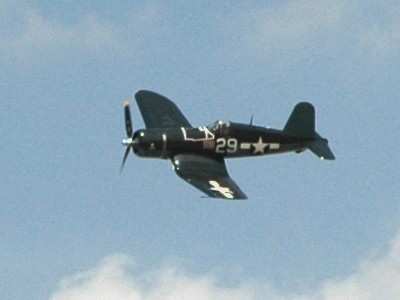Presented By A Representative Of Saiki City, Japan
A representative from Saiki City, Japan, presented the remains of a World War II F4U Corsair fighter-bomber to the U.S. Navy at the Naval History and Heritage Command's (NHHC) Archaeology and Conservation Laboratory March 22.

Yoshiro Kishida was present for the receipt of the shipment and NHHC Director Sam Cox accepted the artifacts on behalf of the command.
"The receipt of these artifacts marks the end of one journey and the beginning of another," Cox said. "The conservation stage will begin. Our archeologists and historians will learn from these artifacts and, ultimately, share the story of these important pieces of naval heritage."
Cox thanked Kishida, letting him know the artifacts are in good hands.
The conservation team at the Archaeology and Conservation Laboratory will assess the condition of the artifacts and determine what treatment is necessary to stabilize them. The parts will also be documented and the data gathered will be cross-referenced with NHHC records to learn more about them.
"We are delighted that the mayor and city have decided to send these artifacts to the Naval History and Heritage Command," said Jay Thomas, the assistant director for the collections management division at NHHC. "We look forward to conserving them, and to sharing them and their story in the United States."
Once stabilized, the artifacts will be made available for public display through the NHHC Archaeological Artifact Loan Program. Currently 80 percent of the command's archaeological artifact collection is on loan to various institutions throughout the country and in Europe.
On March 18, 1945, 19 F4U Corsair fighter-bombers, including those of Fighter Squadron (VF) 10, took off from aircraft carrier USS Intrepid (CV 11). Their target was a naval air base on the northern end of Kyushu, the southernmost of Japan's home islands. By attacking Japanese airfields in range of that island they could deny air support to the defending garrison.
The "Grim Reapers" hit their target but at a cost of two aircraft flown by two new pilots. One Corsair hit the ground during the attack itself and the other, damaged in the air raid, made an emergency water landing off the coast of Saiki. The plane sank and according to U.S. historical documentation, the pilot's body was never recovered.
The Corsair was rediscovered by accident almost 50 years later when the propeller and engine became ensnared in a fisherman's net. A local citizen funded an attempted recovery of the rest of the aircraft, but in the end only the engine, propeller and part of a wing were salvaged. These items were put on display in 2007 at Saiki's Yawaragi Peace Memorial Hall alongside the parts of other aircraft from the Pacific War.
In 2015, the decision was made to return the Corsair parts to the United States as a goodwill gesture on the 70th anniversary of the war's end. Saiki City's intention was to return it to the aircraft carrier that launched it 70 years ago, Intrepid, now a museum ship in New York City.
The curation team at the Intrepid Sea, Air and Space Museum redirected the city of Saiki to NHHC to coordinate return of the Corsair components. All U.S. Navy sunken military craft, including warplanes, remain U.S. government property no matter when or where they were downed and are protected from unauthorized disturbance under the Sunken Military Craft Act.
Archaeological conservator Shanna Daniel commented, "We are really looking forward to working on these pieces and cannot wait to begin documentation and starting the conservation process."
(Source: U.S. Navy news release. Image from file)
 Airborne 07.02.25: TikToker Arrested, Vietnam A/L Ground Hit, ATC Modernization
Airborne 07.02.25: TikToker Arrested, Vietnam A/L Ground Hit, ATC Modernization Airborne Affordable Flyers 07.03.25: Sonex HW, BlackShape Gabriel, PRA Fly-In 25
Airborne Affordable Flyers 07.03.25: Sonex HW, BlackShape Gabriel, PRA Fly-In 25 ANN's Daily Aero-Term (07.07.25): Discrete Code
ANN's Daily Aero-Term (07.07.25): Discrete Code Classic Aero-TV: DeltaHawk Aero Engine Defies Convention
Classic Aero-TV: DeltaHawk Aero Engine Defies Convention ANN's Daily Aero-Linx (07.07.25)
ANN's Daily Aero-Linx (07.07.25)



